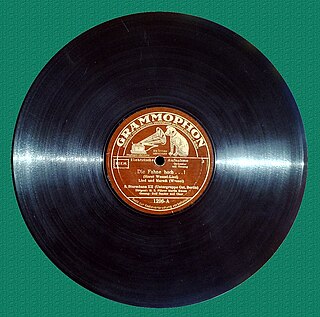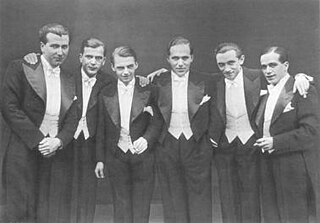
The "Deutschlandlied", officially titled "Das Lied der Deutschen", has been the national anthem of Germany either wholly or in part since 1922, except for a seven-year gap following World War II in West Germany. In East Germany, the national anthem was "Auferstanden aus Ruinen" between 1949 and 1990.

The "Horst-Wessel-Lied", also known by its opening words "Die Fahne hoch", was the anthem of the Nazi Party (NSDAP) from 1930 to 1945. From 1933 to 1945, the Nazis made it the de-facto co-national anthem of Nazi Germany, along with the first stanza of the "Deutschlandlied".

The Comedian Harmonists were an internationally famous, all-male German close harmony ensemble that performed between 1928 and 1934 as one of the most successful musical groups in Europe before World War II. The group consisted of Harry Frommermann, Asparuh "Ari" Leschnikoff, Erich A. Collin, Roman Cycowski (baritone), Robert Biberti (bass), and Erwin Bootz (pianist).
"The Faithful Hussar" is a German song based on a folk song known in various versions since the 19th century. In its current standard form, it is a song from the Cologne Carnival since the 1920s.

"Rufst du, mein Vaterland" is the former national anthem of Switzerland. It had the status of de facto national anthem from the formation of Switzerland as a federal state in the 1840s, until 1961, when it was replaced by the Swiss Psalm.
"Apples and Bananas" or "Oopples and Boo-noo-noos" is a traditional North American children's song that plays with the vowels of words. The first verse usually begins unaltered:
Volkslied is a genre of popular songs in German which are traditionally sung. While many of them were first passed orally, several collections were published from the late 18th century. Later, some popular songs were also included in this classification.

Hans-Joachim Hessler is a German composer, musician and musicologist. Today, he lives in Duisburg and Diemelsee. As a contemporary composer, he attributes his work in writing and composition to the epoch of musical postmodernism.

"Traum durch die Dämmerung", is both a German poem by Otto Julius Bierbaum and a Lied by Richard Strauss, his Op. 29/1. The opening line is "Weite Wiesen im Dämmergrau". It is the first of three songs by Strauss based on love poems by Bierbaum, composed and published in Munich in 1895, and dedicated to Eugen Gura. The works were scored for medium voice and piano, and published by Universal Edition as 3 Lieder mit Klavierbegleitung, later with English versions and orchestral arrangements.

"Vom Himmel hoch, da komm ich her" is a hymn text relating to the Nativity of Jesus, written by Martin Luther in 1534. The hymn is most often sung to the melody, Zahn No. 346, which first appeared in a 1539 songbook and was probably also composed by Luther. This classic Christmas carol remains popular and has inspired many choral and organ works by other composers.
"Vom Himmel hoch, o Engel, kommt", also known as "Susani", is a German Christmas carol. It was first printed in 1622 as an alternate text to an older melody. In eight stanzas of two lines each, the angels are requested to come from Heaven, bring their musical instruments, and play and sing of Jesus and Mary, and ultimately for peace for the people.
Franz Schubert's best-known music for the theatre is his incidental music for Rosamunde. Less successful were his many opera and Singspiel projects. On the other hand, some of his most popular Lieder, like "Gretchen am Spinnrade," were based on texts written for the theatre.

"Maria durch ein Dornwald ging" is a German Advent song. By origin it was a pilgrimage song that initially was spread orally in the 19th century, starting in the Catholic Eichsfeld.

"Das Grab ist leer, der Held erwacht" is a Catholic hymn for Easter, first printed in 1777 in the hymnal Landshuter Gesangbuch published by Franz Seraph von Kohlbrenner. Keeping only the first of five stanzas, with additional two stanzas, it appeared in hymnals of the 19th century, and later in different versions in several regional sections of the Catholic hymnal Gotteslob. It is a frequently sung hymn in Easter services.

"Ein Haus voll Glorie schauet" is a popular German Catholic hymn, frequently sung during pilgrimages, during the consecration of churches (Kirchweihe), and on their subsequent anniversaries. Text and tune were written and composed, in a similar tempo to the Prussian Army military marches that were widely popular under the Second Reich, as an anthem of nonviolent resistance to Otto von Bismarck's anti-Catholic Kulturkampf by Fr. Joseph Mohr in 1875. The lyrics were changed significantly for the post-Vatican II Catholic hymnal Gotteslob, with stanzas two to five written by "Hans W. Marx" in 1972, which has since attracted criticism by some Traditionalist Catholics. It has inspired musical settings for festive occasions such as the millennium of the Bamberg Cathedral.

Sechs Lieder, Op. 68, is a collection of six Lieder by Richard Strauss. He composed them, setting poems by Clemens Brentano, in 1918 for soprano and piano, and orchestrated one in 1933 and five in 1940. The piano version was first published by Adolph Fürstner in Berlin in 1919. They are also known as Brentano Lieder.
This is a list of German television related events from 1977.

"Mit Ernst, o Menschenkinder" is an Advent hymn by Valentin Thilo. It partly paraphrases the call to penitence by John the Baptist. The text was first published in 1642 in the collection Preußische Festlieder. The different melody that later became popular dates back to 1557.

Ein Jäger aus Kurpfalz is a German folk song. It celebrates a hunter freely riding across the land and hunting, and is traditionally associated with the Soonwald forest and the Hunsrück uplands of the Palatinate (Kurpfalz). The later stanzas feature somewhat crude sexual exploits of the hunter; modern songbooks, especially those used by children, usually remove stanzas 3, 4, and 5. The base melody has been used and remixed in a variety of ways, from military marches to pleasant public event themes.














